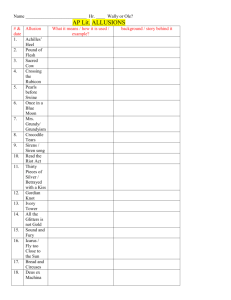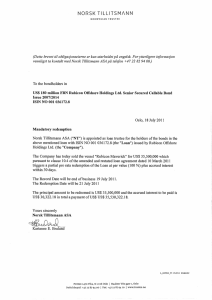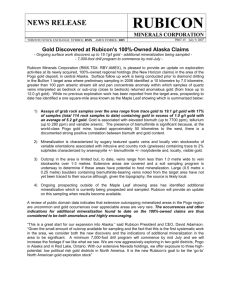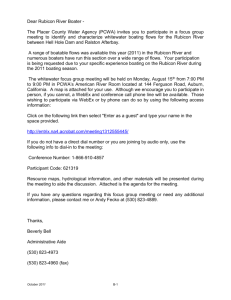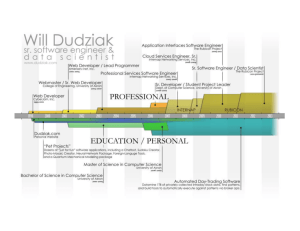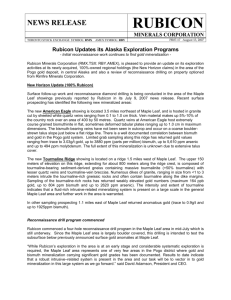Rubicon: Bounded Verification of Web Applications Please share
advertisement
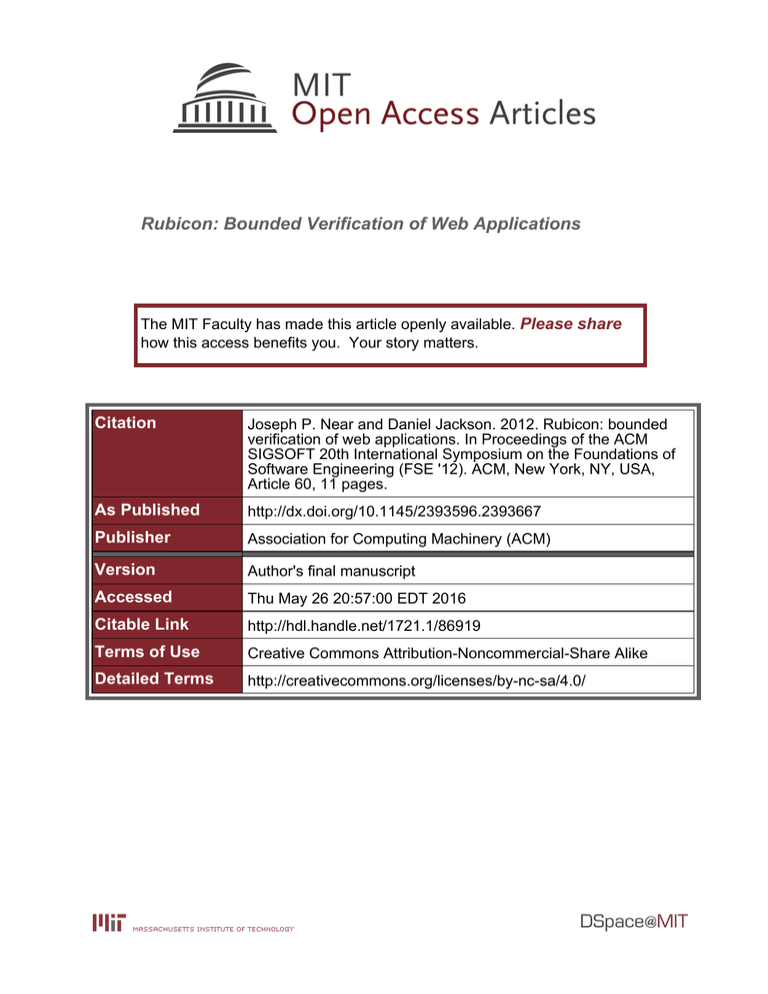
Rubicon: Bounded Verification of Web Applications
The MIT Faculty has made this article openly available. Please share
how this access benefits you. Your story matters.
Citation
Joseph P. Near and Daniel Jackson. 2012. Rubicon: bounded
verification of web applications. In Proceedings of the ACM
SIGSOFT 20th International Symposium on the Foundations of
Software Engineering (FSE '12). ACM, New York, NY, USA,
Article 60, 11 pages.
As Published
http://dx.doi.org/10.1145/2393596.2393667
Publisher
Association for Computing Machinery (ACM)
Version
Author's final manuscript
Accessed
Thu May 26 20:57:00 EDT 2016
Citable Link
http://hdl.handle.net/1721.1/86919
Terms of Use
Creative Commons Attribution-Noncommercial-Share Alike
Detailed Terms
http://creativecommons.org/licenses/by-nc-sa/4.0/
Rubicon: Bounded Verification of Web Applications
Joseph P. Near, Daniel Jackson
Computer Science and Artificial Intelligence Lab
Massachusetts Institute of Technology
Cambridge, MA, USA
{jnear,dnj}@csail.mit.edu
ABSTRACT
We present Rubicon, an application of lightweight formal
methods to web programming. Rubicon provides an embedded domain-specific language for writing formal specifications of web applications and performs automatic bounded
checking that those specifications hold. Rubicon’s language
is based on the RSpec testing framework, and is designed to
be both powerful and familiar to programmers experienced
in testing. Rubicon’s analysis leverages the standard Ruby
interpreter to perform symbolic execution, generating verification conditions that Rubicon discharges using the Alloy
Analyzer. We have tested Rubicon’s scalability on five realworld applications, and found a previously unknown security bug in Fat Free CRM, a popular customer relationship
management system.
Keywords
Formal methods, programming languages, web programming
1.
INTRODUCTION
Web applications have experienced explosive growth over
recent years. Testing methodologies for web applications are
beginning to catch up, but despite their utility in building
correct programs, there has been as yet little use of formal
methods in the domain.
This paper introduces Rubicon, an application of lightweight
formal methods to web programming. Rubicon allows programmers to write specifications of the behavior of their web
application and performs automatic bounded analysis to
check those specifications against the implementation. Rubicon aims to be both powerful and easy to use: its specification language is expressive but based on a domain-specific
language for testing.
Rubicon is implemented as a library for the Ruby programming language, and targets applications written using the
popular Rails web programming framework. Rubicon’s spec-
ification language is an extension of the Ruby-based RSpec
domain-specific language for testing [7]; Rubicon adds the
quantifiers of first-order logic, allowing programmers to replace RSpec tests over a set of mock objects with general
specifications over all objects. This compatibility with the
existing RSpec language makes it easy for programmers already familiar with testing to write specifications, and to
convert existing RSpec tests into specifications.
Rubicon’s automated analysis comprises two parts: first,
Rubicon generates verification conditions based on specifications; second, Rubicon invokes a constraint solver to check
those conditions. The Rubicon library modifies the environment so that executing a specification performs symbolic
execution, producing verification conditions rather than values. To check the verification conditions, Rubicon currently
compiles them into Alloy [14], a lightweight specification language for software design, for analysis using the Alloy Analyzer, a fully-automatic bounded analysis engine for Alloy.
Alloy’s relational language is convenient because its semantics closely match those of relational databases, but in principle, an unbounded SMT solver or theorem prover could be
used in place of Alloy.
We tested Rubicon’s performance on five open-source web
applications for which the original developers have written
RSpec tests. We took a random sample of these tests and
converted them into Rubicon specifications; in every case,
Rubicon’s analysis took no more than a few seconds per
specification. In the largest of these applications, a customer
relationship management system called Fat Free CRM, Rubicon’s analysis uncovered a previously unknown security
bug. The authors of Fat Free CRM have acknowledged this
bug and are preparing a fix.
We have released Rubicon under the terms of the GPL at:
http://people.csail.mit.edu/jnear/rubicon.
The contributions of this paper include:
• Rubicon, a domain-specific language for expressing specifications of web applications;
• a scalable, automatic, symbolic-execution-based bounded
checker for Rubicon specifications;
• an evaluation of Rubicon on five applications, and the
discovery of a previously unknown security bug.
describe UsersController do
it ”should expose the requested user as @user and
render [show] template” do
@user = Factory(:user)
get :show, : id => @user.id
assigns [: user ]. should == @user
response . should render template( ”users/show”)
end
end
1
2
3
4
5
6
7
8
9
describe ContactsController do
it ”should redirect to contact index if the contact
is protected ” do
@private = Factory(:contact , : user =>
Factory(:user), : access => ”Private”)
get :show, : id => @private.id
flash [: warning ]. should not == nil
response . should redirect to (contacts path)
end
end
10
11
12
13
14
15
16
17
Figure 1: RSpec Tests for Displaying Users and Restricting Access to Private Contacts
2.
THE RUBICON LANGUAGE
Rubicon provides an embedded domain-specific language for
writing specifications. This language is based on RSpec [7],
a testing framework for the Ruby language whose goal is to
make testing easier and more useful, and that has made testdriven design popular amongst Ruby programmers. RSpec
tests are concise, avoid repetition, and resemble English
specifications of application features. The framework also
encourages programmers to write documentation for each
test by providing fields for that documentation and using it
to generate error reports when tests fail.
The Rubicon language is designed for writing specifications
of Rails applications. Rails is the most popular web programming framework for Ruby, and was designed specifically
to allow testing with RSpec. The integration of Rails with
RSpec means that test-driven development is just as popular
in the Rails community as it is in the larger Ruby community, and many open-source Rails applications are shipped
with large RSpec test suites.
2.1
The RSpec Approach
To introduce the style of testing promoted by the RSpec
library, we take the open-source Rails application Fat Free
CRM1 as a case study. Fat Free CRM is a customer relationship management system designed to be used to build
customized CRM systems for use in organizations. Development of Fat Free CRM began in 2008 and the software
is currently maintained by Michael Dvorkin and Nathan
Broadbent. Fat Free CRM is released under the AGPL,
its codebase comprises 23kloc, but is reasonably simple to
understand, and the developers have written more than 1000
RSpec tests.
Figure 1 contains two examples of RSpec tests from the Fat
1
http://www.fatfreecrm.com/
Free CRM codebase. The first (lines 1-8) is intended to
test that the show action correctly displays summaries of
the site’s users. What it actually tests is that a particular
user (created by the call to the Factory) is displayed. The
test begins with a natural-language specification of the feature under test (line 2); the body of the test (lines 3-7) is
Ruby code written in the RSpec domain-specific language.
This particular test constructs a mock object representing
a single user (line 3), requests the summary page for that
user (line 4), and then checks that the user that will be displayed matches the mock object just created (line 5). This
check is written as an RSpec assertion, the general form of
which is a.should p b, where a and b are objects and p is a
predicate describing the desired relationship between them.
The assigns variable is actually a Ruby hash populated by
the Rails framework to contain the names and values of the
instance variables set by the page request in line 4.
The second test (lines 10-17) is intended to check that private contacts are never displayed to users other than their
owners. What it actually tests is that a particular private
contact is hidden from a particular user. The test begins by
building a mock object for the private contact owned by a
mock user (line 12). The test then attempts to display the
private contact (line 13). Since the mock user created as the
owner of the contact in line 12 is by default distinct from the
mock user representing the currently logged-in user, this request should fail. The test checks that it does indeed fail by
asserting that the value of flash [: warning], which displays
site errors, is populated (line 14), and that the user should
be redirected to the index of contacts (line 15).
The example tests in Figure 1 check the desired properties
in only a single case; they may easily miss corner cases that
the programmer does not anticipate. For example, the second test passes, but the intended property—that the show
action in the contacts controller preserves permissions—is
actually false! In fact, displaying a contact also causes a
summary of the associated opportunities to be displayed;
these opportunities also have associated user permissions.
The test either ignores the fact that opportunities will be
displayed, or assumes that the permissions on these opportunities will match those on the corresponding contact. If
they do not, a user may be allowed to see another user’s
private opportunity. This is an example of a corner case
that is unlikely to be caught by testing alone, since testing requires the programmer to specify exactly one case to
test—and the programmer is likely to test only the case in
which the permissions match.
2.2
Adding Quantifiers
Rubicon allows programmers to write specifications for web
applications by extending the RSpec language with the quantifiers of first-order logic. Rather than testing just a single case for compliance with the application’s specification,
Rubicon performs symbolic execution for a truly arbitrary
case, generates verification conditions that cover all possible cases, and uses an automatic bounded verifier to check
them.
Rubicon introduces two new methods on objects—forall and
exists—which represent the universal and existential quantifiers of first-order logic. Both methods accept a single argu-
SpecFile
Spec
Expr
Pred
::
::
::
|
|
|
|
|
|
|
|
|
::
|
|
|
|
|
|
describe <class> do <Spec∗> end
it <string> do <Expr∗> end
<Ruby Expression>
<object>. forall do |x| <Expr> end
<object>.exists do |x| <Expr> end
<class>. forall do |x| <Expr> end
<class>.exists do |x| <Expr> end
<Expr>.implies do <Expr> end
<object>.should equal <Expr>
<object>.should not equal <Expr>
<object>.should <Pred> <Expr>
<object>.should not <Pred> <Expr>
==
be
include
raise
throw
respond to
have
Figure 2: Syntax of Rubicon Specifications
1
2
3
4
5
6
7
8
9
describe UsersController do
it ”should expose the requested user as @user and
render [show] template” do
User.forall do |user|
get :show, : id => user.id
assigns [: user ]. should == user
response . should render template( ”users/show”)
end
end
end
10
11
12
13
14
15
16
17
18
19
20
21
22
23
24
25
describe ContactsController do
it ”should redirect to contact index if the contact
is protected ” do
User.forall do |user|
Contact.forall do |private|
set current user(user)
get :show, : id => private.id
((private.access == ”Private”) &
(private.user != user)).implies do
flash [: warning ]. should not == nil
response . should redirect to (contacts path)
end
end
end
end
end
Figure 3: Rubicon Specifications for Displaying
Users and Restricting Access to Private Contacts
ment: a Ruby block, representing the property over which
the quantifier ranges; quantifiers succeed or fail in the same
way as other RSpec tests.
Figure 2 specifies the core syntax of Rubicon specifications.
Rubicon’s syntax is exactly that of RSpec, with the addition
of quantifiers. A set of Rubicon specifications begins with a
describe block specifying the class being specified; each individual specification is written inside an it block with a string
documenting that specification. A specification is simply a
sequence of expressions, each of which may be a standard
Ruby expression or a Rubicon assertion. A quantifier is also
an assertion; a.forall do |x| b end means that the assertions
in b should hold for all possible values of x from the set
a, and a.exists do |x| b end means that the assertions in b
should hold for at least one value of x from a.
Figure 3 presents Rubicon versions of the RSpec tests from
Figure 1. This specification for displaying users (lines 1-9)
quantifies over all users, rather than testing the intended
property for just a single user. The block passed to the
forall method is precisely the code we wrote in the original
test—only the underlined code has changed, reflecting the
introduction of quantified variables in place of mock objects.
The specification for restricting access to private contacts
(lines 11-25) changes only slightly more. In order to check
that permissions are preserved no matter which user is logged
in, we quantify over users (line 13) and then set the loggedin user correspondingly (line 15). To express the class of
contacts for which the property should hold, we introduce
a logical implication (lines 17-18) whose left-hand side requires that the contact’s access should be set to private and
that its owner should be distinct from the logged-in user.
2.3
The Power of Specification
By writing full specifications of application behavior, programmers can catch errors that tests alone are unlikely to
find. Rubicon’s automated analysis of formal specifications
can explore corner cases, check for general regression errors,
and build complicated object hierarchies for testing—areas
in which standard RSpec tests fall short. Moreover, Rubicon
specifications are often more concise than the RSpec tests
they replace, since the programmer may replace complicated
code for constructing mock objects with simpler quantifiers.
The previously mentioned fault involving the permissions on
opportunities associated with contacts, for example, is unlikely to be caught in testing, since its discovery requires the
specific situation in which the user in question has permission to view a particular contact, but does not have permission to view the associated opportunity. Because mock
objects must take concrete values, a programmer will tend
to construct mock objects that represent the most common
situation—in this case, one in which the permissions on the
contact and its associated opportunities match.
In writing specifications, on the other hand, the tendency
is to provide as little information as possible, so as to have
the highest chance of discovering corner cases that were not
considered by the programmer. The Rubicon specification
in Figure 4 checks the property that permissions are actually respected when displaying a contact. The specification
1
2
3
4
5
6
7
describe ContactsController do
it ”should not display other users ’ private contacts
or opportunities ” do
User. forall do |u|
Contact. forall do |c|
Opportunity. forall do |o|
set current user (u)
get :show, : id => c.id
1
2
3
4
5
6
7
8
9
10
11
12
((c. access == ’private’ ) &
(c. user != u)). implies do
assigns [: contact ]. should not == c
end
13
14
15
16
17
18
19
20
21
22
23
8
9
10
11
((o. access == ’private’ ) &
(o. user != u)). implies do
assigns [: contact ]. opportunities should not
include o
end
end
end
end
end
end
xhr :post, : create , : contact => { :first name =>
”Billy”}, :account => {}, :opportunity => 987
assigns (: contact) . opportunities . should
include (@opportunity)
response . should render template( ”contacts/create ”)
end
end
Figure 5: RSpec Test for Contact Creation
1
2
3
4
5
6
Figure 4: Rubicon Specification for Displaying Contacts
describe ContactsController do
it ”should be able to associate newly created
contact with the opportunity ” do
@opportunity = Factory(: opportunity , : id => 987);
@contact = Factory.build (: contact)
Contact.stub !(: new).and return(@contact)
7
describe ContactsController do
it ”should not associate another user ’ s private
opportunity with newly created contact” do
User. forall do | user |
Contact. forall do |contact |
Opportunity. forall do | opportunity |
set current user (user)
xhr :post, : create , : contact =>
contact.attributes , : opportunity =>
opportunity.id
8
quantifies over users, contacts, and opportunities (lines 35), sets the current user to the quantified one (line 6), and
requests the contact display page (line 7). The specification
then checks two properties: first, that for any contact, if
that contact’s permissions are set to private and its contact’s
owner is not the current user, then that contact should not
be displayed (lines 9-12); and second, that for any opportunity, if that opportunity’s permissions are set to private
and its owner is not the current user, then that opportunity should not be included in the list of opportunities to be
displayed (lines 14-17).
This specification makes no assumptions about any properties of the contact and opportunities in question; most
importantly, it does not rule out the case that the requested
contact is public, but one of the associated opportunities is
private and not owned by the current user. Indeed, Rubicon catches this case immediately, returning the following
counterexample for the second property:
1
2
3
4
5
=> u = User { : id => 1 ... }
c = Contact { :access => ’public’ , : user => u,
: opportunities => [o] ... }
o = Opportunity { :access => ’private’ ,
: user => user1 ...}
This counterexample represents the case in which the current user owns the contact being displayed, but does not own
the opportunity associated with that contact. Even though
that opportunity is private, it will be displayed to the user.
The blame for this fault lies in the assumption, made in
9
10
11
12
13
14
15
16
17
(( opportunity . user != user) &
( opportunity . access==’private’)) . implies do
assigns [: contact ]. opportunities . should not
include opportunity
end
end
end
end
end
end
Figure 6: Rubicon Specification for Contact Creation
the show action of the contacts controller, that the permissions and ownership of a contact and its opportunities will
be identical. The show method uses the my method of the
Contact class to determine which contact to display; the developers of Fat Free CRM have redefined the my method
elsewhere so as to return only those records that the current
user has permission to view. Referencing a particular contact’s opportunities field, however, accesses the associated
opportunities directly, bypassing the redefined my method,
and ignoring the opportunities’ permissions settings. If a
user has permission to display a contact, then, he or she will
be able to access all of its associated opportunities, regardless of their permission settings.
2.4
Exploiting the Bug
The corner case discovered in the previous section only qualifies as a serious security bug if it is possible to exploit it.
The exploit described in the counterexample requires an in-
E(obj. forall
E(obj. exists
E(obj.should
E(obj. should
E(e)
variant on the database to be broken—that the permissions
of all the opportunities associated with a particular contact
are compatible with the permissions on that contact. Rubicon can help us again, this time in checking whether or
not it is possible to create a new contact that violates the
invariant.
Invariants can be checked the same way using tests, but the
contrived nature of test cases makes this strategy less useful than might be hoped—run-time assertions checking for
invariant violations are therefore much more popular. Figure 5 contains the RSpec test written by the Fat Free CRM
developers to check that the invariant is preserved. As usual,
this test uses mock objects (lines 3-5) to construct the common case—one with the default permissions—creates a new
contact (line 7), and tests that the opportunity is correctly
associated with the contact (line 8).
The corresponding Rubicon specification (Figure 6), on the
other hand, quantifies over all users, contacts, and opportunities (lines 3-5), constructs a new contact associated with
the quantified opportunity (line 7), and checks that if the
opportunity is private and not owned by the current user,
then it should not be included in the resulting contact’s set
of associated opportunities (lines 9-11)—in other words, it
should be impossible to create a contact that violates the
invariant.
Once again, Rubicon’s analysis yields a counterexample, informing us that it is indeed possible to violate the invariant:
1
2
3
=> user = User { :id => 1 ... }
contact = Contact { : opportunities => [opportunity]
... }
opportunity = Opportunity { :access => ’private’ ,
: user => user1 }
Investigating the code for the create action in the contacts
controller, we found that the code that looks up the attached opportunity uses the find method, rather than the
permission-enforcing my method, to find the opportunity
whose ID is referenced in the HTML form submitted by
the user.
Exploiting this security bug, then, is as easy as submitting a
contact creation request with the ID of another user’s opportunity in the “ opportunity id ” HTML field. The developers
of Fat Free CRM have acknowledged the bug, and are working on a fix.
3.
THE RUBICON ANALYSIS
Rubicon is implemented as a library on top of Ruby, RSpec,
and Rails. It extracts verification conditions from specifications by using the standard Ruby interpreter to perform
symbolic, rather than concrete, execution; instead of concrete values, this style of execution produces abstract syntax
trees representing the appropriate verification conditions.
Rubicon then compiles the verification conditions into an
Alloy [14], a lightweight specification language for software
engineering, and performs bounded analysis using the Alloy
Analyzer.
b)
b)
p e)
not p e)
≡
≡
≡
≡
≡
∀x. E(b. call (x))
∃x. E(b. call (x))
E(obj.p(e))
¬E(obj.p(e))
RubyInterpreter (e)
Figure 7: Semantics of Rubicon Specifications
C(obj. forall b)
C(obj. exists b)
≡
≡
all(x, C(b. call (x))
some(x, C(b. call (x))
(x is a new symbolic object)
C(obj.should p e)
C(obj. attribute )
C(obj.meth(args))
C(obj.where(e))
≡
≡
≡
≡
call(:should ,C(obj),C(p),C(e))
field ref( C(obj),C(args))
call( meth, C(obj), C(args))
query( v, obj , C(e))
(if obj is symbolic)
C(e)
≡
RubyInterpreter (e)
(if e is concrete)
Figure 8: Compiling Specifications to Abstract Syntax Trees
3.1
Rubicon’s Semantics
Rubicon’s semantics are intended to match those of Ruby
precisely, and to combine Ruby’s semantics in a natural way
with the standard semantics of the quantifiers of first-order
logic. Figure 7 contains an informal summary of Rubicon’s
semantics, using the standard quantifier symbols (∀, ∃) and a
function representing the semantics of the standard Ruby interpreter (RubyInterpreter). Given standard quantification
over Ruby values, we can represent Rubicon’s basic assertions (should and should not) by simply invoking the predicate on the object in question; a true result means that the
assertion holds. It is the goal of Rubicon’s implementation
to implement these semantics faithfully.
3.2
Rubicon’s Implementation
To implement the semantics in Figure 7, Rubicon transforms specifications into verification conditions represented
as abstract syntax trees and checks those conditions using a
constraint solver. Figure 8 summarizes that transformation;
the transformation is based on the use of symbolic objects
defined by the Rubicon library to represent quantified variables.
To avoid re-implementing the Ruby interpreter, Rubicon implements the transformation from Figure 8 by persuading
the standard Ruby interpreter to perform symbolic execution. Rubicon accomplishes this by defining symbolic objects in such a way that all method invocations on symbolic
objects yield abstract syntax trees rather than values. Since
specifications necessarily refer to symbolic objects if they use
quantifiers, Rubicon can use the results of running code with
symbolic objects to build abstract syntax trees representing
verification conditions for the specification.
This strategy works especially well for web applications, for
two reasons: first, the database schema of a web application specifies exactly the set of possible symbolic objects;
T(all(x, e))
T(some(x, e))
T(field ref(obj, f ))
T(call(:include, obj, a))
T(call(:==, obj, a))
T(query(name, type, e))
T(call(:should, obj, p, a))
T(v )
≡
≡
≡
≡
≡
≡
≡
≡
all x: typeOf(x) | T(e)
some x: typeOf(x) | T(e)
T(obj). f
T(obj) in T(a)
T(obj) = T(a)
{ name: type | T(e) }
T(call(p, obj, a) )
v
Figure 10: Compiling Abstract Syntax Trees to Alloy Specifications
Figure 9: Comparison Between RSpec Execution
and Rubicon Analysis
these operations, and the should method for building assertions is also redefined to produce abstract syntax trees. As
a result, the following Ruby expression:
1
and second, web applications typically move much of the
application’s logic into the database, so the remaining code
has few branches. These two facts lend our approach its
scalability: by limiting the number of symbolic objects, we
perform as much execution as possible over concrete objects
(using the standard Ruby interpreter) and reduce the size of
the resulting verification conditions; and because the code
contains few branches, the branch-explosion problem that
typically plagues symbolic execution does not occur.
A diagram comparing Rubicon’s execution model to that of
RSpec is presented in Figure 9. Rubicon’s analysis proceeds
in three parts: first, the Rubicon library stubs the standard
libraries and ActiveRecord objects; second, Rubicon runs
the specification body in the standard Ruby interpreter, producing verification conditions; and finally, Rubicon compiles
those verification conditions for the Alloy Analyzer to check.
3.3
Preprocessing: Stubbing Objects
Rails uses the ActiveRecord class as the basis for its objectrelational mapper. In a standard Rails application, every
object to be stored in the database is descended from ActiveRecord. To determine the set of classes that should be
represented by symbolic objects, then, Rubicon builds a list
of all the classes descended from ActiveRecord.
The next step is to stub those classes—replacing them with
new classes that respond the same way to the operations defined on them, but with different behavior. Rubicon takes
each ActiveRecord class and redefines two basic types of
methods: class methods that query the database, and instance methods that allow the programmer to get and set
the attributes (values to be stored in the database) of an
object representing a particular record in the database. For
example, the call User.all returns a list of all users, and given
a user object, user.id returns that user’s ID number.
Rubicon redefines these methods to produce abstract syntax
trees rather than values: User.all returns Expr Call(:all, User),
and user.all returns Expr Field Ref(user, :id).
The classes that define abstract syntax trees are defined so
that methods invoked on them produce new trees reflecting
user1 . id . should == user2.id
Evaluates to the following abstract syntax tree, instead of
a value (Expr Call represents the constructor of an abstract
syntax tree node):
1
Expr Call (: should , :==, Expr Field Ref(user1 , : id ) ,
Expr Field Ref (user2 , : id ))
Having prepared the environment this way, running Rubicon
specification code in the standard Ruby interpreter yields
abstract syntax trees representing verification conditions.
3.4
Postprocessing: Producing Alloy Specifications
All that remains is to translate verification conditions into
Alloy specifications. Since our abstract syntax trees are designed for this purpose, doing so is straightforward. We
summarize the translation in Figure 10.
The Alloy language includes all of first-order relational logic,
plus transitive closure. Quantifiers, therefore, are translated into their analogues in Alloy; field references become
relational joins based on Alloy’s global relations, database
queries become Alloy set comprehensions, and Rubicon assertions turn into logical formulas.
Alloy’s universe is made up of uninterpreted atoms, which
are divided into sets based on user-defined signatures. In
addition to designating a set of atoms, signatures may define
global relations; Alloy specifications are typically based on
these global relations, and logical formulas are built from
the results of relational joins or membership tests over these
relations.
Rubicon uses Alloy’s atoms to represent objects. It defines
a signature for each type of object that is mentioned in a
given specification, with relations to represent the values of
the object’s fields. Given this representation, a field reference in Ruby is equivalent to a relational join in Alloy. This
paradigm is popular in Alloy, so the syntax of relational
join is designed to make the representation of a field reference appear similar to the typical syntax in programming
languages—obj.f means the relational join of the atom obj
with the global relation f, but it also represents the reference
to field f of object obj, given our encoding.
1
2
3
To generate a complete Alloy specification, Rubicon constructs a signature definition for every class referenced in
the corresponding Rubicon specification. For each signature, Rubicon consults the application’s database schema
(encoded in the ActiveRecord) to determine the set of attributes associated with that type, and adds a field definition
to the signature for each attribute. For example, the first
part of the signature definition for the User class from Fat
Free CRM is as follows:
4
5
6
def show
@contact = Contact.my.find(params[:id ])
@stage = Setting. unroll (: opportunity stage )
@comment = Comment.new
...
end
7
8
9
10
11
12
User. forall do |u|
Contact. forall do |c|
Opportunity. forall do |o|
set current user (u)
get :show, : id => c.id
13
1
2
3
4
5
6
7
sig User {
name: String ,
created at : Datetime,
updated at: Datetime,
email : String ,
...
}
14
15
16
17
18
19
20
21
Rubicon combines these signature definitions with the translated verification conditions and invokes the Alloy Analyzer
to determine whether or not the specification is satisfied.
The Alloy Analyzer is a tool for automatic bounded analysis of Alloy specifications; it places finite bounds on the
number of each type of atom present in the universe, then
reduces the specification to propositional logic. The Analyzer uses a model finder, Kodkod [21], which translates
to boolean satisfiability (SAT) using algorithms that optimize relational expressions. This makes Kodkod, and thus
Alloy, especially suited to database applications. If a counterexample is found, Kodkod maps the SAT result back to
a valuation for the original specification’s relations.
Rubicon, in turn, maps the counterexample Alloy produces
back to a Ruby object structure, which forms the printed
counterexample the user sees when a specification is found
not to hold.
3.5
An Example: Contact Permissions
As a complete example of Rubicon’s analysis, consider the
example of checking that the user has permission to view
a contact and its associated opportunities (Figure 4). Figure 11 demonstrates how the second of these two properties
is checked.
((o. access == ’private’ ) &
(o. user != u)). implies do
assigns [: contact ]. opportunities should not
include o
end
end
end
end
⇒
22
23
24
25
26
27
28
29
30
31
Expr Implies (
Expr And(
Expr Call(:==, Expr Field Ref(o, : access) ,
’ private ’ ) ,
Expr Call (:!=, Expr Field Ref (o, : user) ,
u)) ,
Expr Not(
Expr Call (: include ,
Expr Field Ref (c, : opportunities ) ,
o)))
⇒
32
33
34
35
36
37
38
39
40
41
one sig string private extends String {}
sig Opportunity{
id : ID, access : String , ..., user : set User
}
sig Contact{
id : ID, access : String , ..., opportunities : set
Opportunity
}
sig User{
id : ID, ...
}
42
First, during execution by the Ruby interpreter, the property, along with the Fat Free CRM implementation (in this
case, the show method defined in full in Figure ??), produce
a verification condition to be checked by the Alloy Analyzer.
The page request (line 12) passes the quantified contact’s ID
to the show method, where the call to the stubbed version of
Contact.my.find (line 2) yields a symbolic record representing precisely the quantified contact. The method returns,
having set assigns [: contact ] to that symbolic record.
The two conditions on the left-hand side of the implication
(line 15) evaluate to expressions involving the quantified opportunity; the condition on the right-hand side of that implication (line 16) evaluates to an expression involving both
43
44
45
46
47
48
49
check {
all u: User |
all c: Contact |
all o: Opportunity |
(o. access = string private and
o. user != u) implies
!(o in c. opportunities )
50
51
} for 5
Figure 11: Verification Condition and Corresponding Alloy Specification
properties of the application’s behavior, rather than properties about the database schema, so we considered them
both a better test of Rubicon’s ability to check an application’s behavior and more likely to find behavioral bugs in
the application.
1100
1000
900
Solving Time (ms)
800
700
We converted all of the tests from each selected file into Rubicon specifications by replacing mock objects with quantifiers over objects. This process was straightforward for
most tests, since the natural language description of each
test combined with the Ruby code implementing it generally described the intent of the test.
600
500
400
300
200
100
0
0
2
4
6
8
10
Finite Bound (Scope)
12
14
Figure 12: Effect of Finite Bound on Solving Time
of Verification Conditions from Examples in Figures
3, 4, and 6
the symbolic record constructed above and the quantified
opportunity. The expression representing the complete verification condition is listed in lines 22-31.
Second, the Rubicon postprocessor produces an Alloy specification equivalent to the verification condition. Each expression type produced by the methods Rubicon stubs corresponds directly to an Alloy expression. Rubicon wraps the
verification condition produced above with the appropriate
quantifiers, combines it with a set of signatures corresponding to the classes used in the specification, and produces the
Alloy specification listed in lines 32-51.
4.
EVALUATION
To confirm that Rubicon’s analysis is capable of scaling to
real applications, we tested it on five open-source Rails applications whose distributions contain RSpec tests written
by the original developers. We tried to select applications
that perform a variety of tasks and that have a sizable user
base. All of the applications we examined contain extensive
RSpec test suites with documentation. The five applications
we examined are:
• Insoshi, a social networking platform
• Fat Free CRM, a customer relationship management
platform
• RubyTime, a time-management system
• RubyURL, a URL-shortening service
• Tracks, an application to implement the “Getting Things
Done” methodology
4.1
Methodology
For each application, we selected a random subset of the
files containing developer-written RSpec tests for the application’s controllers. The controller tests tend to express
We ran both the original RSpec tests and our Rubicon specifications on an Intel Core 2 Duo E7500 with 4GB RAM under Ubuntu 10.04 and Ruby 1.8.7, with the latest version of
each application (when available, the development version).
Rubicon makes use of version 4.1 of the Alloy Analyzer.
By default, Rubicon uses a finite bound of five during analysis, meaning that the corresponding Alloy Analyzer analysis
searches for a counterexample in universes containing five
atoms or fewer per Ruby class. We used this bound in our
experiments.
Specifications from this evaluation are available on the Rubicon webpage.2
4.2
Results
We converted a total of 250 developer-written RSpec tests
into Rubicon specifications. The table in Figure 13 contains
a summary of the size of each application, the filenames of
the test files we converted, the number of tests per file, the
average execution time of the original tests and their associated Rubicon specifications, and a comparison between the
number of lines of code used before and after the conversion
to Rubicon.
The results show that while analyzing Rubicon specifications is several times slower, on average, than executing the
original RSpec tests, Rubicon’s analysis usually takes only
a second or two. Moreover, converting the original RSpec
tests into Rubicon specifications made the source code only
11% longer, suggesting that writing Rubicon specifications
may not be significantly more difficult than writing RSpec
tests.
Figure 14 is a visual representation of the range of perspecification analysis times for each of the test files in Figure 13. For each test file, the bar represents the average
analysis time over all of that file’s specifications; the extent
of the error bars represents the maximum and minimum
analysis time for any specification in that file. The maximum analysis time for any test we converted was just over
five seconds; more importantly, the maximum and minimum
analysis times were always close to the average, suggesting
that Rubicon’s analysis is consistently fast.
To evaluate the effect of the finite bound on Rubicon’s analysis time, we generated the Alloy specifications corresponding
to each of the four Rubicon specifications listed in this paper
2
http://people.csail.mit.edu/jnear/rubicon
Filename
Number
of Tests
Average RSpec
Time per Test
Average Rubicon
Time per Test
Original RSpec
Lines of Code
Rubicon
Lines of Code
27
4
14
45
0.41s
0.52s
0.38s
0.44s
1.52s
1.86s
2.08s
1.82s
272
42
126
440
314
57
143
514
8
21
27
53
109
0.64s
0.53s
0.42s
0.44s
0.51s
2.45s
2.12s
1.87s
1.97s
2.10s
98
254
343
696
1391
115
301
386
754
1556
31
11
42
0.32s
0.28s
0.30s
2.11s
2.54s
2.35s
271
104
375
294
132
426
8
8
0.36s
0.36s
2.63s
2.63s
73
73
94
94
20
26
46
0.27s
0.23s
0.25s
2.16s
2.46s
2.31s
182
174
356
207
197
404
Insoshi (12k LOC)
people controller spec.rb
topics controller spec.rb
comments controller spec.rb
Totals
Fat Free CRM (23k LOC)
home controller spec.rb
comments controller spec.rb
users controller spec.rb
contacts controller spec.rb
Totals
RubyTime (11k LOC)
users spec.rb
clients spec.rb
Totals
RubyURL (1k LOC)
links controller spec.rb
Totals
Tracks (22k LOC)
todo spec.rb
user spec.rb
Totals
Figure 13: Case-Study Summary: the Number of Tests, Average Runtime of Original Test and Corresponding
Rubicon Specification, and Lines-of-Code Comparison Between Original Tests and Rubicon Specifications
6
Solving Time (s)
5
4
3
2
1
0
.rb
b
c.r
b
c.r
pe
b
c.r
r_s
pe
.rb
ec
sp
b
.rb
ec
sp
c.r
er_
pe
lle
r_s
b
lle
.rb
ec
tro
ec
sp
on
sp
o_
er_
us
tod
_c
b
tro
c.r
c.r
pe
pe
_s
_s
nts
ks
lin
clie
ers
us
on
oll
r_s
ntr
lle
co
tro
_c
on
cts
_c
nta
co
ers
us
ts_
pe
er_
b
.rb
c.r
pe
oll
r_s
ntr
lle
co
tro
ts_
on
en
_c
me
mm
co
ho
en
r_s
ec
sp
er_
lle
oll
tro
ntr
on
co
_c
le_
ics
mm
co
top
op
pe
Figure 14: Range of Analysis Times for Rubicon Specifications: Average, Maximum, and Minimum Analysis
Times for Each Test File
(in Figures 3, 4, and 6) and manually tested the differences
in solving times at different scopes using the Alloy Analyzer.
The results of this experiment are displayed in Figure 12. As
is common with SAT-based analyses, the solving time begins
to increase exponentially as the finite bound rises above ten
atoms per class. Rubicon’s default bound of five is a compromise attempting to produce consistently fast analysis times
without missing bugs.
4.3
Fat Free CRM Bug
Of the RSpec tests we converted, only one led to the discovery of a previously unknown bug. As discussed in Sections 2.2 and 2.3, testing the permissions of both contacts
and their associated opportunities, along with the ability of
bounded analysis to explore corner cases, allowed us to discover a situation in which a user can view another user’s
private opportunities.
Several other tests we converted led us to the discovery (also
discussed in Section 2.3) that the Fat Free CRM developers
had redefined the ActiveRecord my method to enforce permissions. Rubicon also redefines this method, and interprets
the resulting verification condition as if its use has the semantics originally intended by the Rails developers. The
result was a false positive: Rubicon originally reported that
any user could view any entity in the system, regardless of
permissions. We worked around this problem by renaming
the method defined by Fat Free CRM and calling it directly.
This was the only Fat Free CRM issue that caused false
positives to be reported by Rubicon.
5.
RELATED WORK
Rubicon’s specification language is based on the RSpec domainspecific language for testing [7]. Our approach of embedding
an expressive specification language directly in a programming language is most heavily influenced by QuickCheck [10],
a random testing framework for Haskell in which the programmer specifies properties by writing code.
Rubicon’s analysis is based on symbolic execution, which
was originally developed by King [16] and which has seen
both popular use and refinement (e.g. [15]) since its inception. Symbolic execution is itself a form of abstract interpretation, which was formalized by Cousot [11]. The two techniques remain popular with the program analysis community. Rubicon’s back-end solver is based on Alloy [14], which
is itself based on the Kodkod relational model finder [21].
Existing work on the application of formal methods to web
applications focuses on modeling applications, and especially
on building navigation models. Bordbar and Anastasakis [4],
for example, model a user’s interaction with a web application using UML, and perform bounded verification of properties of that interaction by translating the UML model into
Alloy using UML2Alloy; other approaches ( [17,20]) perform
similar tasks but provide less automation.
Most techniques focus specifically on navigation from one
page to another, and can analyze only those properties related to possible navigations. Some existing work ( [1, 5])
models possible navigations using UML, others ( [3]) using
directed graphs, and still others ( [8, 12, 22]) using statecharts.
Those techniques that allow programmers to specify an application’s behavior are closest in their aim to our own work.
Syriani and Mansour [19] use SDL (the Specification and Description Language) to model some aspects of application,
and provide automatic test case generation based on the
model. Haydar et al. [13] use communicating automata to
build the application’s model, and have explored techniques
for verifying properties of those automata. Finally, Andrews
et al. [2] use finite state machines to model applications, and
also generate test cases. All of these techniques require the
programmer to build a separate model of their web application’s behavior, and limitations of the modeling technique
used mean the set of properties that can be checked is also
limited. Rubicon, in contrast, is capable of checking any
property expressible in first-order logic.
Techniques that do not require the programmer to build a
model of the application tend to focus on the elimination
of a certain class of bugs, rather than on full verification.
Chlipala’s Ur/Web [9] statically verifies user-defined security
properties of web applications, and Chaudhuri and Foster [6]
verify the absence of some particular security vulnerabilities
for Rails applications. Nijjar and Bultan [18] translate Rails
data models into Alloy to find inconsistencies.
6.
CONCLUSION
Rubicon brings together the ideas of testing, formal specification, symbolic execution, and bounded analysis, and applies them to web applications. Its combination of RSpec
and quantifiers is powerful enough to express rich behavioral
specifications without requiring programmers to learn a new
specification language. Leveraging the Ruby interpreter to
perform symbolic execution allows Ruby to execute concrete
parts of the application directly, resulting in smaller verification conditions and thus increased scalability. This style of
symbolic execution also resulted in decreased development
time of the Rubicon tool, since no separate symbolic evaluator had to be developed, and means that users need not
install a separate symbolic evaluator. Finally, the relational
language and analysis of Alloy and its Analyzer are a perfect match for the database-oriented verification conditions
Rubicon generates.
While it remains to be seen if the use of Rubicon is costeffective, we are encouraged by the ability of our prototype
implementation to perform analyses on non-trivial opensource Rails applications, and by the fact that it has already
exposed a bug missed in several years of testing. We hope
that Rubicon’s availability as open-source software will encourage web developers to begin writing and checking specifications.
7.
REFERENCES
[1] L. Alfaro. Model checking the world wide web. In
Proceedings of the 13th International Conference on
Computer Aided Verification, pages 337–349.
Springer-Verlag, 2001.
[2] A.A. Andrews, J. Offutt, and R.T. Alexander. Testing
web applications by modeling with fsms. Software and
Systems Modeling, 4(3):326–345, 2005.
[3] M. Benedikt, J. Freire, and P. Godefroid. Veriweb:
Automatically testing dynamic web sites. In In
[4]
[5]
[6]
[7]
[8]
[9]
[10]
[11]
[12]
[13]
[14]
[15]
[16]
[17]
[18]
[19]
Proceedings of 11th International World Wide Web
Conference (WWW’2002). Citeseer, 2002.
B. Bordbar and K. Anastasakis. Mda and analysis of
web applications. Trends in Enterprise Application
Architecture, pages 44–55, 2006.
D. Castelluccia, M. Mongiello, M. Ruta, and
R. Totaro. Waver: A model checking-based tool to
verify web application design. Electronic Notes in
Theoretical Computer Science, 157(1):61–76, 2006.
A. Chaudhuri and J.S. Foster. Symbolic security
analysis of ruby-on-rails web applications. In
Proceedings of the 17th ACM conference on Computer
and communications security, pages 585–594. ACM,
2010.
D. Chelimsky, D. Astels, Z. Dennis, A. Hellesoy,
B. Helmkamp, and D. North. The rspec book:
Behaviour driven development with rspec, cucumber,
and friends. Pragmatic Bookshelf, 2010.
J. Chen and X. Zhao. Formal models for web
navigations with session control and browser cache.
Formal Methods and Software Engineering, pages
46–60, 2004.
A. Chlipala and LLC Impredicative. Static checking of
dynamically-varying security policies in
database-backed applications. In Proceedings of the 9th
USENIX conference on Operating systems design and
implementation, page 1. USENIX Association, 2010.
K. Claessen and J. Hughes. QuickCheck: a lightweight
tool for random testing of Haskell programs. Acm
sigplan notices, 35(9):268–279, 2000.
P. Cousot and R. Cousot. Abstract interpretation: a
unified lattice model for static analysis of programs by
construction or approximation of fixpoints. In
Proceedings of the 4th ACM SIGACT-SIGPLAN
symposium on Principles of programming languages,
pages 238–252. ACM, 1977.
L. De Alfaro, T.A. Henzinger, and F.Y.C. Mang.
Mcweb: A model-checking tool for web site debugging.
In Poster presented at WWW, volume 10. Citeseer,
2001.
M. Haydar, A. Petrenko, and H. Sahraoui. Formal
verification of web applications modeled by
communicating automata. Formal Techniques for
Networked and Distributed Systems–FORTE 2004,
pages 115–132, 2004.
D. Jackson. Software Abstractions: logic, language,
and analysis. The MIT Press, 2006.
S. Khurshid, C. Păsăreanu, and W. Visser.
Generalized symbolic execution for model checking
and testing. Tools and Algorithms for the Construction
and Analysis of Systems, pages 553–568, 2003.
J.C. King. Symbolic execution and program testing.
Communications of the ACM, 19(7):385–394, 1976.
DR Licata and S. Krishnamurthi. Verifying interactive
web programs. In Automated Software Engineering,
2004. Proceedings. 19th International Conference on,
pages 164–173. IEEE.
J. Nijjar and T. Bultan. Analyzing ruby on rails data
models using alloy. GSWC 2010, page 39, 2010.
J. Syriani and N. Mansour. Modeling web systems
using sdl. Computer and Information Sciences-ISCIS
2003, pages 1019–1026, 2003.
[20] P. Tonella and F. Ricca. Dynamic model extraction
and statistical analysis of web applications. 2002.
[21] E. Torlak and D. Jackson. Kodkod: A relational model
finder. Tools and Algorithms for the Construction and
Analysis of Systems, pages 632–647, 2007.
[22] M. Winckler and P. Palanque. Statewebcharts: A
formal description technique dedicated to navigation
modelling of web applications. Interactive Systems.
Design, Specification, and Verification, pages 279–288,
2003.
